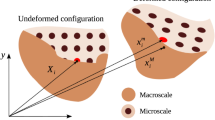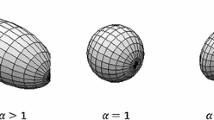Abstract
This paper presents a statistical micromechanics-based multi-scale material modeling framework to predict the effective elastic moduli of porous materials. The present formulation differs from most of the existing theoretical models in that the interaction effects among the pores are directly accounted for by considering the pair-wise interaction and the statistical information of pore distribution is included by applying the ensemble volume averaging process. The theory of average fields is employed to derive the stress and strain concentration factor tensors that relate the local average fields to the global averages. Closed-form and analytical explicit expressions for the effective elastic moduli of porous materials are obtained in terms of the mechanical properties of the matrix material and porosity. The dependence of effective elastic properties on the porosity is investigated. Comparison of our theoretical prediction with the results of the published experimental data and other existing theoretical models is performed to illustrate the predictive capability of the proposed framework for porous materials.
Similar content being viewed by others
References
A. P. Roberts and E. J. Garboczi, J. Amer. Ceram. Soc. 83(12) (2000) 3041.
M. A. Qidwai, P. B. Entchev, D. C. Lagoudas and V. G. Degiorgi, Int. J. Solids and Struc. 38 (2001) 8653.
R. Hill, J. Mech. and Phys. Solids 13(4) (1965) 213.
B. Budiansky, ibid. 13(4) (1965) 223.
R. W. Zimmerman, Mech. Mater. 12 (1991) 17.
T. Mori and K. Tanaka, Acta Metallurgica 21(5) (1973) 571.
R. W. Rice, J. Mater. Sci. 31 (1996) 1509.
C. T. Herakovich and S. C. Baxter, ibid. 31 (1999) 1595.
R. Hill, J. Mech. and Phys. Solids 48 (1963) 367.
G. J. Dvorak, in “Metal Matrix Composites: Mechanisms and Properties,” edited by R. K. Everett and R. J. Arsenualt (Academic Press, Boston, USA, 1991).
T. Mura, “Micromechanics of Defects in Solids,” 2nd ed. (Kluwer Academic Publishers, 1987).
K. H. Tseng, Ph.D. Dissertation, Princeton University, Princeton, New Jersey, 1995.
R. L. Coble and W. D. Kingery, J. Amer. Ceram. Soc. 39(11) (1956) 377.
J. B. Walsh, W. F. Brace and A. W. England, ibid. 48(12) (1965) 605.
J. A. Haglund and O. Hunter, ibid. 56(6) (1973) 327.
O. Hunter, H. J. Korklan and R. R. Suchomel, ibid. 57(6) (1974) 267.
N. Ramakrishnan and V. S. Arunachalam, ibid. 76(11) (1993) 2745.
Z. Hashin, J. Appl. Mech. 29 (1962) 143.
Z. Hashin and S. Shtrikman, J. Mech. Phys. Solids 11 (1963) 127.
Author information
Authors and Affiliations
Corresponding author
Rights and permissions
About this article
Cite this article
Wang, L., Tseng, K.K. A multi-scale framework for effective elastic properties of porous materials. Journal of Materials Science 38, 3019–3027 (2003). https://doi.org/10.1023/A:1024736105732
Issue Date:
DOI: https://doi.org/10.1023/A:1024736105732




